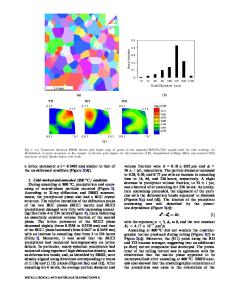Effect of High Temperature Annealing on the Microstructure of SCS-6 SiC Fibers
- PDF / 5,844,064 Bytes
- 6 Pages / 420.48 x 639 pts Page_size
- 41 Downloads / 360 Views
EFFECT OF HIGH TEMPERATURE ANNEALING ON THE MICROSTRUCTURE OF SCS-6 SiC FIBERS X. J. Ning, P. Pirouz and R. T. Bhatt* Department of Materials Science and Engineering, Case Western Reserve University Cleveland, OH 44106 *NASA Lewis Research Center, Cleveland, OH 44135 ABSTRACT The effect of annealing the SCS-6* SiC fiber for one hour at 2000'C in an argon atmosphere is reported. The SiC grains in the fiber coarsen appreciably and the intergranular carbon films segregate to the grain junctions. It would appear that grain growth in the outer part of the fiber is primarily responsible for the loss in fiber strength and improvement in fiber creep resistance. INTRODUCTION SiC fibers are potential candidates as reinforcements for high-temperature ceramic-matrix composites. Thus, an understanding of the fiber microstructure and its relation to the mechanical properties of the fiber is essential. In particular, it is important to know the changes that take place in the microstructure of the fibers that have undergone high temperature exposure. Such changes may have a significant effect on the high temperature mechanical properties of the fiber. Thus, it has been reported that the tensile strength of SCS-6 fiber decreases significantly after high temperature annealing [ 1,2]. Also, DiCarlo found that the creep resistance of thermally annealed fibers at temperatures greater than 14000C was enhanced [1]. In this paper, a microstructural characterization of SCS-6 fibers after annealing at 20000C in argon will be presented. The microstructure of the annealed fiber is compared to that of an as-received, un-annealed, fiber. The microstructure of the SCS-6 fiber has been already investigated in detail [3]. Figure 1 shows a schematic diagram of the microstructure of an SCS-6 fiber cross-section.
outermost C coating total
thickness:
SiC 4
3pm
71pm7 SiC 2 4.5 pm
FIG. 1. Schematic diagram of the crosssectional microstructure of an as-received SCS-6 fiber (from [3]).
*
Textron Specialty Materials, Lowell, MA Mat. Res. Soc. Symp. Proc. Vol. 250. '1992 Materials Research Society
188
EXPERIMENTAL PROCEDURE SCS-6 fibers were annealed for 1 hour at 2000YC in a graphite element furnace. The fibers were enveloped in a graphite sheet in order to avoid contamination. The furnace temperature was measured with an optical pyrometer with an accuracy of ±10YC. Annealing was carried out in an argon atmosphere (0.1 MPa) of commercial purity. Annealed fibers were mounted in an epoxy mold, mechanically polished and plasma etched for optical microscopy. For preparing TEM specimens, a technique described previously [3] was used. RESULTS The tensile strength of the fiber decreased from -4 GPato 0.7 GPaafter annealing. Fig. 2 is a cross-sectional optical micrograph of the annealed SCS-6 fiber. The coarsening of SiC grains in the outer parts of the fiber, which corresponds to the SiC-4 region in Fig. 1, can be clearly seen.
FIG. 2. Optical micrograph of the annealed SCS-6 fiber cross-section. The fiber was plasmaetched after mechanical polishing.
Data Loading...











